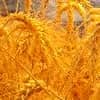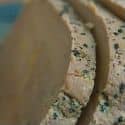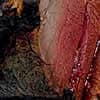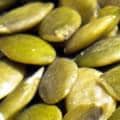Top 10 Foods Highest in Zinc
Zinc is an essential mineral required by the body for maintaining a sense of smell, keeping a healthy immune system, building proteins, triggering enzymes, and creating DNA. Zinc also helps the cells in your body communicate by functioning as a neurotransmitter. A deficiency in zinc can lead to stunted growth, diarrhea, impotence, hair loss, eye and skin lesions, impaired appetite, and depressed immunity. Conversely, consuming too much zinc can lead to nausea, vomiting, loss of appetite, abdominal cramps, diarrhea, and headaches in the short term, and can disrupt absorption of copper and iron in the long term. If you have a zinc deficiency, then animal foods are better sources of zinc than plant foods. The current percent daily value (%DV) for Zinc is 15mg. Below is a list of the top ten foods highest in Zinc.
#1: Oysters
 Depending on type and variety oysters provide 16-182mg of zinc per 100g serving. This accounts for 110%-1200% of the DV for zinc. The food highest in zinc is The Steamed Wild Eastern Oyster which provides 182 mg of zinc per 100g serving, or 76mg (509% DV) in 6 oysters, and 154mg (1029% DV) in a 3 ounce serving.
Depending on type and variety oysters provide 16-182mg of zinc per 100g serving. This accounts for 110%-1200% of the DV for zinc. The food highest in zinc is The Steamed Wild Eastern Oyster which provides 182 mg of zinc per 100g serving, or 76mg (509% DV) in 6 oysters, and 154mg (1029% DV) in a 3 ounce serving.
Click to see complete nutrition facts.
#2: Toasted Wheat Germ

#3: Veal Liver

Click to see complete nutrition facts.
#4: Roast Beef

Click to see complete nutrition facts.
#5: Roasted Pumpkin and Squash Seeds

Click to see complete nutrition facts. Seeds and Nuts with the Fewest Calories.
#6: Dried Watermelon Seeds
 Much like the pumpkin and squash, watermelon seeds are popular in the Middle East and East Asia and they should be in specialty stores catering to those cultures. It is also possible to just eat the seeds raw with the watermelon. You can shell them, or just chew them up whole. Dried watermelon seeds provide 10mg (70% DV) of zinc per 100g serving, 11mg (74 %DV) per cup, and 3mg (19% DV) per ounce.
Much like the pumpkin and squash, watermelon seeds are popular in the Middle East and East Asia and they should be in specialty stores catering to those cultures. It is also possible to just eat the seeds raw with the watermelon. You can shell them, or just chew them up whole. Dried watermelon seeds provide 10mg (70% DV) of zinc per 100g serving, 11mg (74 %DV) per cup, and 3mg (19% DV) per ounce.
Click to see complete nutrition facts.
#7: Dark Chocolate and Cocoa Powder
 Chocolate is showing more and more health benefits and dark chocolate is coming into vogue. Unsweetened baking chocolate provides 9.6mg (64% DV) of zinc per 100g serving (most bars are 50-100 grams). Cocoa powder will provide 6.8mg (45% DV) per 100g, or 5.4mg (39% DV) per cup, 0.3mg (2% DV) per tablespoon. Most milk chocolates provide around 2.3mg (15% DV) per 100g serving or 1mg (7% DV) per bar. Click to see complete nutrition facts. Buy Dark Chocolate from Amazon.com
Chocolate is showing more and more health benefits and dark chocolate is coming into vogue. Unsweetened baking chocolate provides 9.6mg (64% DV) of zinc per 100g serving (most bars are 50-100 grams). Cocoa powder will provide 6.8mg (45% DV) per 100g, or 5.4mg (39% DV) per cup, 0.3mg (2% DV) per tablespoon. Most milk chocolates provide around 2.3mg (15% DV) per 100g serving or 1mg (7% DV) per bar. Click to see complete nutrition facts. Buy Dark Chocolate from Amazon.com
#8: Lamb (Mutton)
 Lamb is a common meat in the Middle East, Mediterranean, and most of Europe, but is increasing in popularity in the Americas. Lamb provides between 4.2-8.7mg of zinc per 100g serving (28%-58% DV) depending on cut. That is up to 7.4mg (49% DV) in a 3 ounce serving (85 grams).
Lamb is a common meat in the Middle East, Mediterranean, and most of Europe, but is increasing in popularity in the Americas. Lamb provides between 4.2-8.7mg of zinc per 100g serving (28%-58% DV) depending on cut. That is up to 7.4mg (49% DV) in a 3 ounce serving (85 grams).
Click to see complete nutrition facts.
#9: Peanuts
 Peanuts are a great source of zinc, 100 grams of oil roasted peanuts will provide 6.6mg (44% DV) of zinc, or 8.8mg (59% DV) in 1 cup chopped, 1.9mg (12% DV) per oz (~39 peanuts). Dry roasted peanuts will provide half as much zinc at 3.3mg (22% DV) per 100 gram serving, or 4.8mg (32% DV) per cup, and 1mg (6% DV) per oz.
Peanuts are a great source of zinc, 100 grams of oil roasted peanuts will provide 6.6mg (44% DV) of zinc, or 8.8mg (59% DV) in 1 cup chopped, 1.9mg (12% DV) per oz (~39 peanuts). Dry roasted peanuts will provide half as much zinc at 3.3mg (22% DV) per 100 gram serving, or 4.8mg (32% DV) per cup, and 1mg (6% DV) per oz.
Click to see complete nutrition facts. Buy Peanuts from Amazon.com
#10: Crab
 Almost any kind of crab will be a great source of zinc. Alaksa King crab in particular provides 7.6mg (51% DV) of zinc per 100 gram serving, which is 10.2mg (68% DV) in an average crab leg, and 6.5mg (43% DV) in a 3 ounce serving. Click to see complete nutrition facts.
Almost any kind of crab will be a great source of zinc. Alaksa King crab in particular provides 7.6mg (51% DV) of zinc per 100 gram serving, which is 10.2mg (68% DV) in an average crab leg, and 6.5mg (43% DV) in a 3 ounce serving. Click to see complete nutrition facts.
Leave a Reply
You must be logged in to post a comment.